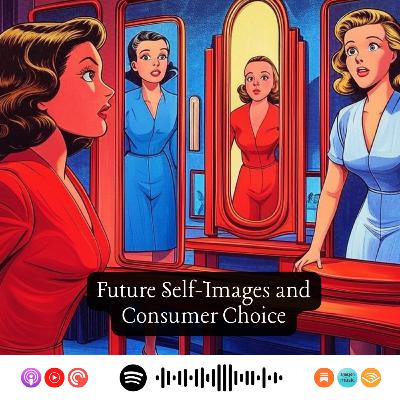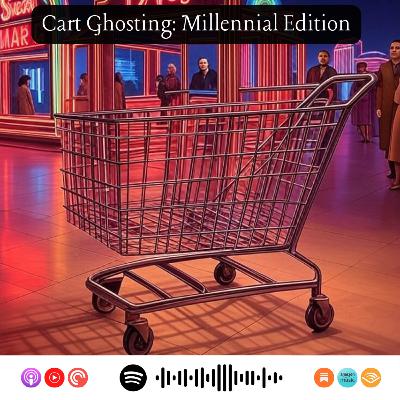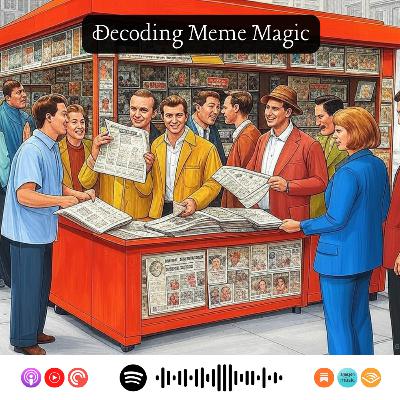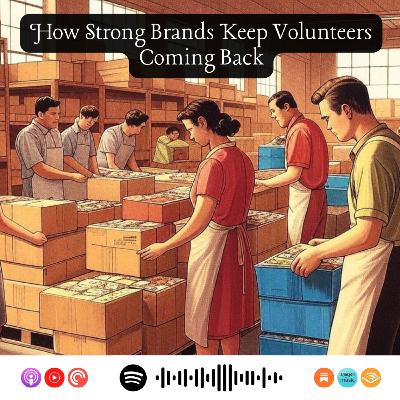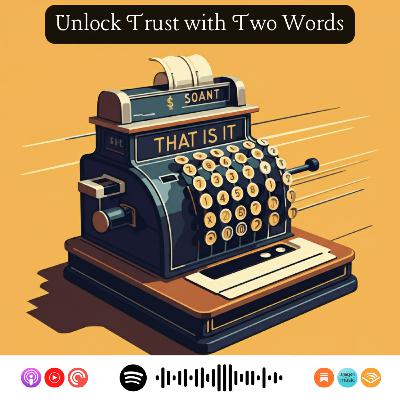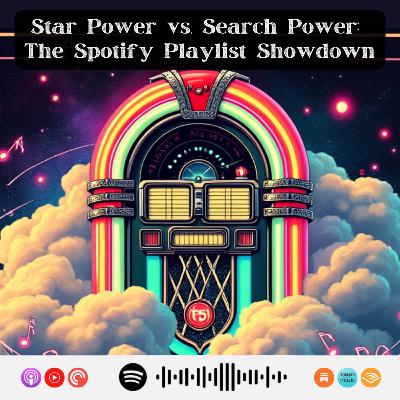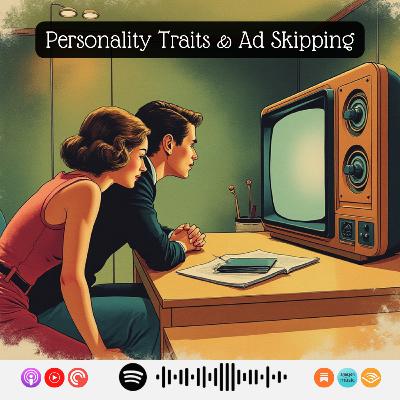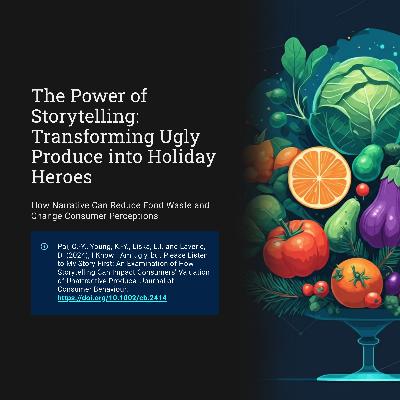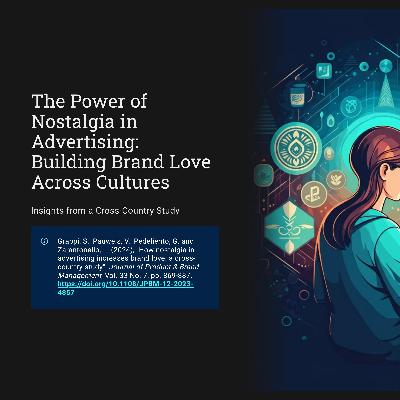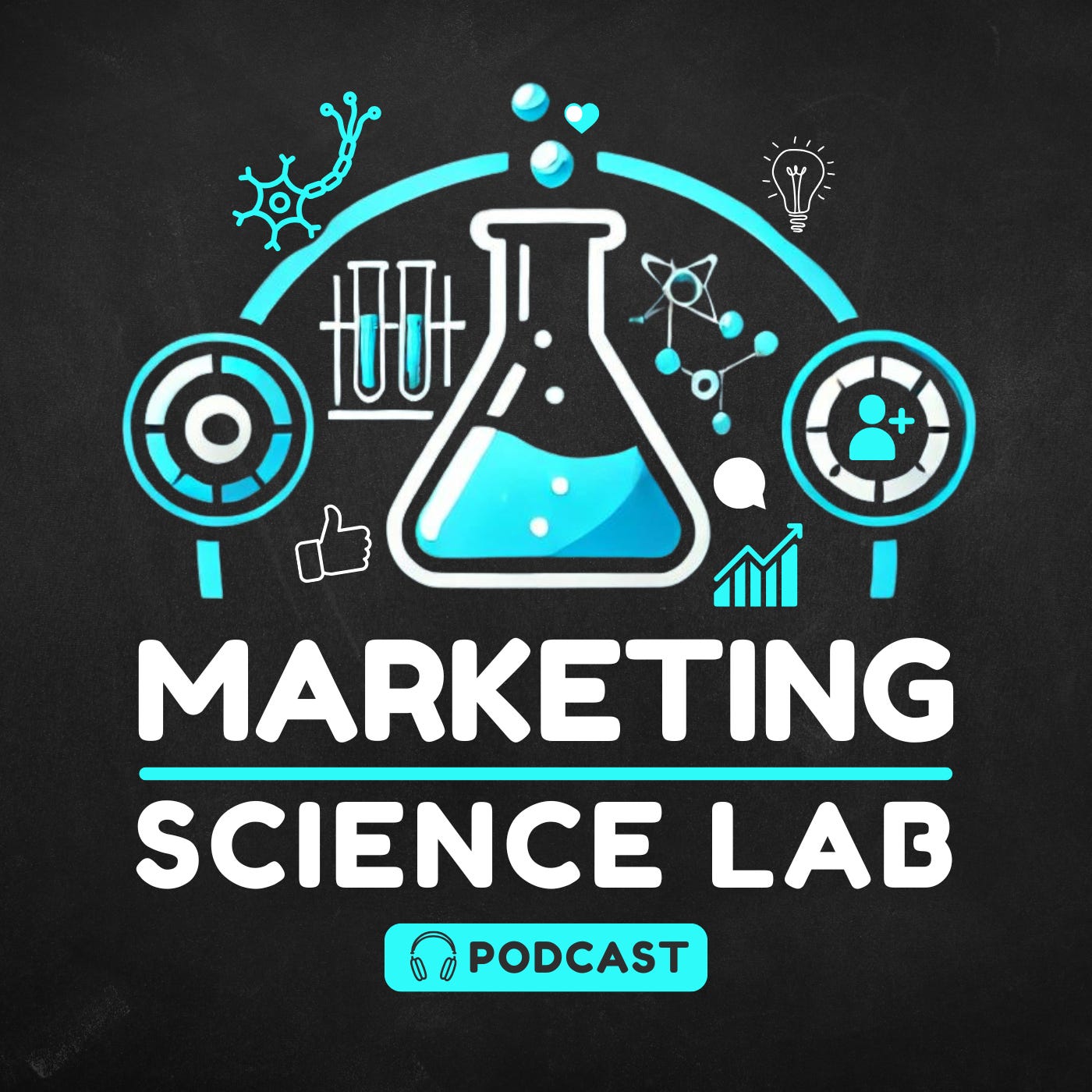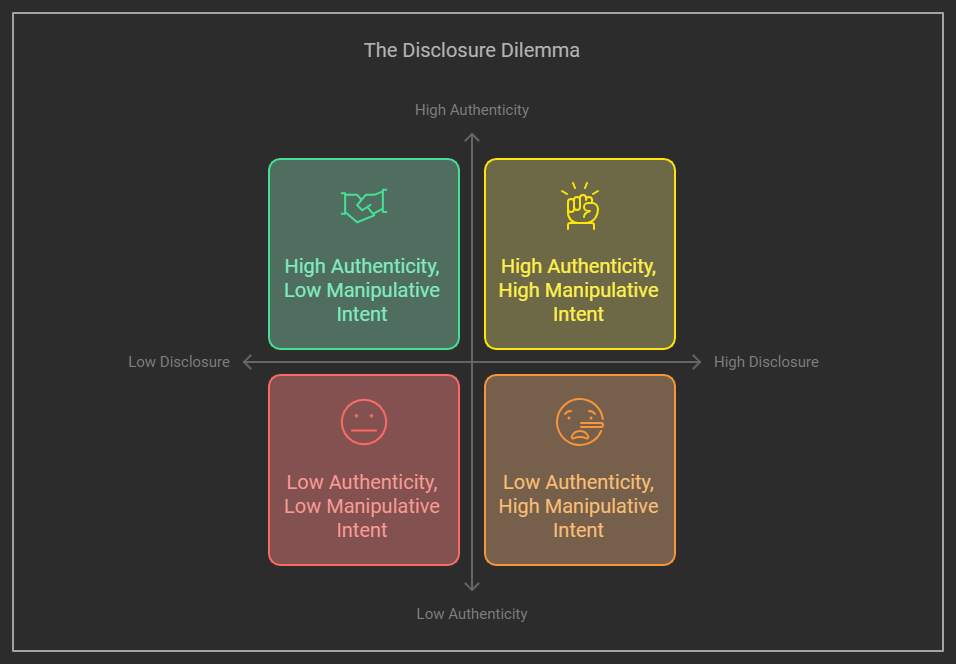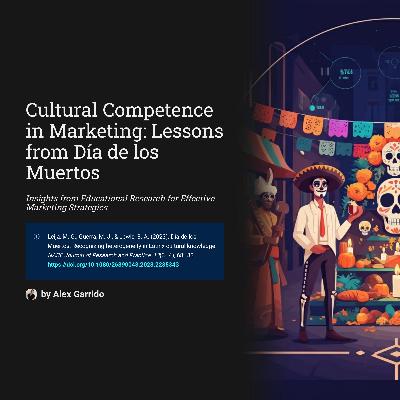Discover Marketing Science Lab
Marketing Science Lab

Marketing Science Lab
Author: Decoding the science of digital persuasion.
Subscribed: 2Played: 7Subscribe
Share
© Decoding the science of digital persuasion.
Description
Welcome to the Marketing Science Lab, where data meets strategy. Join us as we dissect the latest marketing research, uncovering the science behind consumer behavior and effective campaigns. We translate complex studies into actionable insights, empowering you to make informed decisions and achieve measurable results.
www.marketingsciencelab.org
www.marketingsciencelab.org
47 Episodes
Reverse
Source: McColl-Kennedy, J.R., Witell, L., Frow, P., Cheung, L., Payne, A. and Govind, R. (2025), "Patient-centered care in practice: hospital and online primary care settings", Journal of Services Marketing, Vol. 39 No. 10, pp. 15-31. https://doi.org/10.1108/JSM-07-2024-0353Patient-Centered Care (PCC) is fast becoming what the world thinks of as the top standard in healthcare. It is designed to center on patient preferences—on what patients themselves desire, require, and value at every step of their medical experience. This essay looks at how PCC functions in different environments, specifically, in typical hospital settings and in modern online primary care (think telehealth). It looks closely at the four key tenets that characterize patient-centered care and explores elements such as multidisciplinary teams, patient empowerment and self-advocacy, and support from family and friends. The article looks closely at all of these elements because they can have a significant impact on not just patient contentment but also overall health and well-being.
Source: Nikolova, H., & Nenkov, G. Y. (2022). We Succeeded Together, Now What: Relationship Power and Sequential Decisions in Couples’ Joint Goal Pursuits. Journal of Marketing Research, 59(2), 271-289. https://doi.org/10.1177/00222437211034513Ever wondered why, upon accomplishing a common objective, one partner might treat themselves to an extravagant timepiece, while the other diligently continues to utilize money-saving coupons? It’s not simply a question of diverging personalities; it's about the nuances of power dynamics within relationships! This week, we're examining research from the Journal of Marketing Research that illuminates how progress on shared objectives—such as saving for a home—influences individual spending choices in couples, and why grasping power is the key for marketers and couples equally.Core Findings:* Joint Goal Progress Paradox: Couples achieving notable strides toward common financial goals undergo a distinctive psychological transition.* Power Plays a Role: This transition varies; it's significantly shaped by the dynamics of power within the relationship—who holds more influence in decisions.* High-Power = High Indulgence (Maybe): When one partner has more power in the relationship, they are more apt to indulge themselves upon achieving a collective milestone, perceiving it as an individual triumph.* Low-Power = Staying the Course: A partner who perceives that they have less power tends to continue focusing on the joint goal, even if some significant milestone in the goal has been reached.* Relational Self-Concept Boost: This has everything to do with a bump in a partner's idea of themselves; feeling like a "great partner" makes it easy to spend money on personal indulgences without the guilt.* Interventions Work: interventions centered on what the partner has contributed can influence even high-power partners to persist in keeping with the goals of the couple.Actionable Takeaways:* Financial marketers may use insights gleaned from the study by customizing messages to the relationship dynamics of the intended audience. For shared products, emphasize how each partner contributes to and draws benefit from using it—especially for parts of the market where there may be some disparities in who holds the power.* Couples ought to know that post-goal spending tendencies may be impacted by a feeling of individual contribution that is inflated by the disparity in the balance of power. For marketers attempting to target couples, a critical piece to bear in mind is that communication and giving shared credit can mitigate those negative effects.* Valentine's Day Angle: Consider a case when the attainment of a post-Valentine's goal is achieved. In this situation, expect one partner (usually the individual with more power in making decisions) to move more easily than the other toward some self-treats.Understanding how making headway on joint goals connects with relational power offers vital insights for marketers and illuminates day-to-day interactions for couples. It's not only about what goals couples agree to achieve; it's also about how the power of one partner to influence influences both partners' actions following attainment. With knowledge, the correct approaches to conversation, and a commitment to acting as a unit rather than two individuals, couples can move past potential obstacles and toward the long-term economic benefits of staying on track and acting in sync.
Source: Taylor, A. and Carlson, J. (2025), Comparing Who We Are to Who We Could Be: How Future Self-Images Influence Consumer Choices. Psychology & Marketing.https://doi.org/10.1002/mar.22196Ever clicked through your old snapshots on your mobile device and were struck by a wave of nostalgia, a moment of pride, a spark of hope, or, alas, even a twinge of deep regret? Consider that the act of judging past and current versions of yourself is known as "temporal comparison." Now consider this: What occurs if we turn that act around to create a world in which "then" (past) and "now" (present) meet and mix with that ever-elusive time called "the future," where your aspirational self not only beckons but starts "influencing" your consumer behaviors, especially in this curated society where your future self is already "living" and well online? This week, we will extract some lessons for ourselves and lessons, perhaps, for marketers. In fact, we will share with you how that image may well be more powerful—and more lucrative—than some reality that might not arrive until tomorrow.
Source: Sharma, K. and Srivastava, S. (2025), "Shopping cart abandonment among young consumers: a moderated mediation study", Young Consumers, Vol. ahead-of-print No. ahead-of-print. https://doi.org/10.1108/YC-09-2024-2240
Online shopping is the new normal, right? But why do so many filled carts end up abandoned in the digital aisles? This episode, we crack open a fascinating study focused on Millennials and their cart-ditching habits. Spoiler: it’s less about price and more about vibes. Get ready for evidence-based insights, real-world examples, and maybe a little bit of retail therapy, Marketing Science Lab style.
* Core Findings:
* Risk Perception: The Silent Cart Killer: Millennials are savvy shoppers, but they're also risk-aware. Concerns about data security, dodgy websites, and hidden fees are MAJOR drivers of cart abandonment. The study confirms – perceived risk acts like a silent checkout saboteur.
* Choice Process Satisfaction (CPS): Your Secret Weapon: Here’s the game-changer: A satisfying, seamless online shopping experience dramatically weakens the negative impact of perceived risk. When the browsing, selection, and checkout are smooth and even enjoyable, risk becomes a minor speed bump, not a deal-breaker. Think ‘retail flow state’.
* Self-Efficacy? Surprisingly…Secondary: Tech skills matter, but they're not the full story. The study reveals that shopper confidence with tech (self-efficacy) doesn’t significantly change the risk-abandonment dynamic. It's the overall feel of the process that truly counts.
* Moderated Mediation Magic (Explained Simply): Perceived risk mediates the path from intention to abandonment, BUT, Choice Process Satisfaction moderates this mediation. Translation: Risk drives abandonment, unless satisfaction steps in and weakens that risk’s power. Satisfaction is the moderator – like a volume control for risk's influence.
* Actionable Takeaways (More Specific):
* Fortify Trust Signals: Aggressively build trust. Implement highly visible security badges (Norton, McAfee etc.), offer crystal-clear privacy policies (linked prominently), secure payment gateways (think Stripe, PayPal). A/B test trust seals for optimal placement.
* Hyper-Optimize the Choice Journey: Conduct a UX audit focused specifically on choice satisfaction. Is navigation intuitive? Are filters effective (and working)? Is product information comprehensive and easy to find? A/B test different filter layouts, product display formats, and checkout flows. Streamline everything.
* Elevate the Entire Experience: Think beyond basic functionality. Inject delight into the process. Consider interactive product finders, engaging content, progress bars during checkout (gamification-lite). Focus on creating a positive emotional connection, not just a transaction.
* Real-World Examples (Sharper & More Current):
* Pop Culture: Think of dating apps again – swiping right = intention. Then you land on a profile that screams "AI generated image" or "suspiciously vague bio" (perceived risk). Swipe left, cart abandoned! OR think about trying to buy concert tickets from Ticketmaster - initial excitement turns to frustration with queues, crashes and hidden fees.
* Trending Case: Fast fashion giants like SHEIN and Temu thrive on low prices, drawing in young shoppers. However, concerns about ethical sourcing and data privacy linger (perceived risk). They combat this by aggressive influencer marketing and app gamification to boost ‘choice satisfaction’ (whether ethically sound or not is another debate!).
* Relatable Story: Imagine excitedly adding items for a home makeover on Wayfair or IKEA online. But then the website lags, images load slowly, finding similar items is a nightmare – frustration city! Cart… meet digital trash can.
Source: Mathai, S., Kumar, S., Sreen, N. and Jeswani, S. (2025), "Are social media marketing activities reaping benefits for brands? The moderating role of education", Marketing Intelligence & Planning https://doi.org/10.1108/MIP-02-2024-0137
Show notes: https://www.marketingsciencelab.org/p/does-social-media-work
Social media is everywhere these days, but what effect does it have on brands? This recent research digs into that very question, exploring whether social media marketing (SMM) actually boosts brands by analyzing consumer-based brand equity (CBBE) and continued usage intentions. The study also investigates how educational levels influence the ways consumers respond to brand activities in social media. It’s quite timely work, given the exponential growth of social media in our marketing world.
Source: Kim, M. and Baek, T.H. (2025), "Fostering brand love through branded memes on social media", Journal of Product & Brand Management, Vol. ahead-of-print No. ahead-of-print. https://doi.org/10.1108/JPBM-02-2024-5002
Show Notes: https://www.marketingsciencelab.org/p/decoding-meme-magic
Ever wonder why some branded memes elicit a chuckle and get shared while others fall flat? This episode unpacks fascinating research from the Journal of Product & Brand Management that scientifically examines what makes a good branded meme good. We will break down the key ingredients—from tapping into trends to generating a sense of connection—and show how these digital jokes influence our relationships with brands (both for marketers and consumers). This isn't just about going viral; it's about building genuine brand loyalty. Please note this study focuses specifically on Facebook users.
Source: Wymer, W., & Čačija, L. N. (2025). Brand Strength’s Influence on Volunteers’ Retention and Support Intentions. Journal of Nonprofit & Public Sector Marketing, 1–35. https://doi.org/10.1080/10495142.2024.2448420
Link to show notes: https://www.marketingsciencelab.org/p/brand-strength-and-volunteer-loyalty
This episode dives into a study from the Journal of Nonprofit & Public Sector Marketing that examines how a nonprofit's brand strength makes volunteers stay with them longer and support them over time. This research shows that having a strong brand doesn't just help businesses selling stuff; it's also important for nonprofits that rely on the dedication of volunteers. This is particularly relevant as we approach MLK Day of Service. We should understand what motivates people to offer more than just their time to a nonprofit.
Notable direct quotes from the authors:
"The scientific and practical relevance of this study is that it adds to our knowledge on construct relationships that influence volunteers' retention intentions and intentions to support their organizations in additional ways."
“It is valuable to examine a complex model that reflects the multiple influences at play in a real setting rather than testing a simple model that does not allow for the multiple influences and interactions that are present on volunteers in their actual experience.”
“The importance of brand strength is amplified when its effects on an array of support intentions are better understood.”
Brand Strength: A solid brand significantly increases the likelihood that a volunteer will stick around (both in the near and long term) and support the organization with donations, referrals, and even planned giving. Just look at famous brands like the Red Cross and the YMCA – their reputation likely influences volunteer loyalty.
Transparency Builds Trust and Donations: When an organization is open and honest, volunteers become more willing to donate or plan a bequest to support the work of the nonprofit.
Transparency Amplifiers: When volunteers have high morale, solid training, and feel included in the organization's operations, transparency plays an even stronger role in convincing them to support that nonprofit for the long term.
Factors That Don't Always Matter: Things like age didn’t really change the core link between brand strength and volunteer commitment. There was only a slight influence on long-term retention and recruitment for different age groups.
Source: Mazor, G., Perez, D., & Kronrod, A. (2024). “That’s It!” How Short Exclamations Boost the Effectiveness of Price Communications: Using “Containing Language” to Influence Perceived Price Complexity and Offer Fairness. Journal of Advertising Research, 64(4), 398–415. https://doi.org/10.2501/JAR-2024-025
Full Show notes: https://www.marketingsciencelab.org/p/new-year-clear-prices-how-thats-it
Happy New Year! As we launch into 2025, it’s a great time to freshen up our strategies and be certain our messaging has a laser focus on what we want to convey. Today, we'll explore a piece of research that uncovers a surprisingly simple way to build trust and improve sales. The study shows the kind of simple magic that can exist when we introduce small exclamations into our price communications! It's from the in December 2024, and in this study, phrases like “That’s it” or “Period” can really make a big difference in reducing the perceived price complexity while increasing a prospective buyer’s sense of fair exchange. Let’s discover how these small linguistic adjustments can have big impacts this new year.
Source: Wang, H.S., Yim, C.K.(. Shifting perspectives: How communicating user innovations’ self-focus enhances adoption. J. of the Acad. Mark. Sci. (2024). https://doi.org/10.1007/s11747-024-01068-z
Full Show notes: https://www.marketingsciencelab.org/p/unleash-your-inner-inventor-in-2025
Ready to finally bring that brilliant idea to life in the new year? This episode dives into fascinating research that flips the script on how to market innovations born from personal needs. Forget trying to make your idea fit everyone – learn how embracing its unique, self-focused origins can actually be the key to mass market success. We unpack a groundbreaking study from the Journal of the Academy of Marketing Science that reveals a surprising communication strategy for getting your user innovation adopted.
The User Innovation Paradox: Innovations often start with an individual solving their own problem. While this "self-focus" fuels creativity, it can be a barrier to mass adoption, as the benefits might not seem immediately relevant to others.
Counter-Learning Communication: The research proposes a novel communication strategy that mismatches the typical way people learn about new innovations. By presenting information in a sequence that goes against the grain of how potential adopters naturally process information, you can spark their creativity.
Domain Knowledge Matters: The effectiveness of this strategy hinges on the potential adopter's existing knowledge in the product category.
Domain Adopters (Experts): For those already knowledgeable, presenting the attributes (features) of your innovation before the goal (benefit) encourages them to creatively connect the dots and see its relevance to their own needs.
Non-Domain Adopters (Novices): For those less familiar, presenting the goal first, followed by the attributes, helps them understand the potential before diving into the specifics.
Embrace the Self-Focus: Instead of trying to hide the "user-invented" nature of your product, highlighting the original, personal motivations behind it can actually pique interest and drive adoption by making people think creatively about its potential uses for themselves.
Sustaining the Spark: Maintaining a "self-focused" approach to further development (user inventor solo development) amplifies the positive effects of this communication strategy, versus opening it up to broad customer input which can dilute the original vision.
Know Your Audience: Before launching your innovation, understand the level of expertise your target audience has in the relevant area. Tailor your marketing messages accordingly.
Strategic Sequencing: Experiment with presenting the benefits and features of your innovation in different orders. For expert audiences, lead with the "how"; for novices, start with the "why."
Tell Your Story: Don't shy away from sharing the personal journey behind your invention. Highlight the problem you were trying to solve for yourself. This narrative can spark creative connections in others.
Stay True to Your Vision: While customer feedback is valuable, be mindful of maintaining the core essence of your self-focused innovation during development. Sometimes, the unique perspective is what makes it special.
The "Powerup Dart": The research uses the example of an app-controlled paper airplane. For hobbyists (domain adopters), you might first highlight the technical specs and range (attributes) before explaining the fun and trick potential (goal). For casual users (non-domain adopters), you'd start with the fun aspect and then delve into the technology.The "Perfect" Thermometer: A kitchen thermometer designed by chefs. To reach other professional chefs (domain), emphasize the precision and industrial-grade features first. To reach home cooks (non-domain), focus on the benefit of perfectly cooked meals and ease of use.
Source: Chan, E.Y. (2024), Choice, Psychological Ownership, and Option Valuation. Psychology & Marketing. https://doi.org/10.1002/mar.22150
Full Show Notes: https://www.marketingsciencelab.org/p/more-choices-increase-perceived-worth
This episode explores fascinating research published in Psychology & Marketing (Wiley, 2024) by Eugene Y. Chan, exploring how offering a greater number of choices impacts a consumer's valuation of their selection. Challenging the conventional wisdom of "choice overload," this paper reveals that more options can actually boost the perceived worth of the chosen item by fostering a sense of psychological ownership. Just in time for the holiday season, we unpack how this applies to gift-giving and marketing strategies.
Source: Kathuria, A. and Bakshi, A. (2024), "Unveiling the dynamics that shape online impulse buying behavior", Journal of Research in Interactive Marketing, https://doi.org/10.1108/JRIM-03-2024-0147
Show notes: https://www.marketingsciencelab.org/p/last-minute-holiday-shopping
With Christmas just around the corner, many of us find ourselves caught in the whirlwind of last-minute holiday shopping. But have you ever wondered why those "Limited Time Only!" deals are so hard to resist, especially when you have a credit card in hand? Recent research from the Thapar Institute sheds light on this fascinating phenomenon, revealing the psychology behind our online impulse buying behaviors.
The Perfect Storm: Time Pressure and Easy Payment
The holiday season creates what researchers call a "perfect storm" for impulse purchases. When retailers combine limited-time offers with convenient payment options, they tap into powerful psychological triggers that influence our shopping behavior.
Why Limited-Time Deals Work So Well
Picture this: You're browsing for a gift when you spot a "Next 2 Hours Only!" deal on that perfect item. Your heart rate increases slightly, and before you know it, you're hitting the "Buy Now" button. This reaction isn't just coincidence – it's science. The research reveals that limited-time deals trigger two crucial responses:
* An immediate sense of urgency
* Fear of missing out (FOMO)
These psychological triggers effectively bypass our normal decision-making process, leading to more spontaneous purchases.
The Credit Card Effect
Ever noticed how much easier it is to spend when using a credit card? The research confirms this isn't just perception. Credit cards significantly reduce what researchers call the "pain of payment," making us more likely to make impulsive purchases.
The Role of Pleasure in Shopping
Perhaps the most interesting finding is how hedonic motivation – the pleasure we get from shopping – acts as a crucial bridge between marketing tactics and our buying decisions. This pleasure-seeking aspect becomes even more pronounced during the holiday season, when shopping carries additional emotional weight.
What This Means for Marketers
Effective Strategies:
* Strategic timing of limited-time deals
* Clear visibility of countdown timers
* Prominent display of credit card benefits
* Mobile-optimized shopping experiences
Responsible Marketing:
* Implementation of spending alerts
* Educational resources about financial management
* Cool-off periods for large purchases
Tips for Mindful Holiday Shopping
While these marketing tactics are powerful, understanding them can help us make more conscious shopping decisions:
* Set a holiday budget before browsing
* Use spending alerts on your credit cards
* Take a "cooling off" period before making large purchases
* Be aware of how limited-time deals affect your emotions
The Future of Online Shopping
As e-commerce continues to evolve, understanding these psychological triggers becomes increasingly important for both retailers and consumers. The key lies in finding the balance between effective marketing and responsible consumption.
Whether you're a marketer implementing these strategies or a consumer navigating holiday deals, awareness of these psychological mechanisms can lead to better decisions. After all, the best shopping experiences happen when both retailers and customers win. Remember, while the allure of limited-time deals and the convenience of credit cards can make holiday shopping easier, understanding the science behind these marketing tactics helps us maintain control over our purchasing decisions. Happy mindful shopping!
Source: Max J. Pachali, Hannes Datta (2024) What Drives Demand for Playlists on Spotify?. Marketing Science 0(0). https://doi.org/10.1287/mksc.2022.0273Full Show Notes: https://www.marketingsciencelab.org/p/star-power-vs-search-power-the-spotify
In the ever-evolving landscape of music streaming, playlists have become a crucial battleground for artists, labels, and platforms alike. A groundbreaking study published in Marketing Science has revealed fascinating insights into what drives demand for playlists on Spotify, with implications that could reshape our understanding of music discovery and promotion in the digital age.
The Research: Unpacking Playlist Popularity
Researchers Max J. Pachali and Hannes Datta from Tilburg University set out to answer a critical question: What makes some playlists more successful than others on Spotify? Their study, which analyzed data from over 30,000 popular playlists across 66 music categories, compared two main drivers of playlist demand:
* Being featured on Spotify's Search Page
* Adding songs by exceptionally popular major label artists to playlists
The findings are nothing short of revolutionary for the music industry.
Key Discoveries: The Platform's Power Play
The Featuring Effect
The study found that being featured on Spotify's Search Page increases a playlist's daily followers by a staggering 0.95% on average. To put this into perspective, for a large playlist like "Reggaeton Classic" with 1.9 million followers, being featured could result in approximately 18,050 additional followers in a single day.
The Superstar Effect
In comparison, adding at least one track by a major label superstar artist increases daily followers by 0.45% on average. While still significant, this is less than half the impact of being featured on the Search Page.
Implications for the Music Industry
1. Platform Power
These findings underscore Spotify's significant ability to guide user attention through its Search Page. This supports concerns that the platform can potentially favor certain content producers over others, reshaping the dynamics of music discovery.
2. Value of Superstars
While not as impactful as being featured, superstar artists still play an important role in attracting followers to playlists. This suggests they remain a valuable asset for major music labels, albeit with diminished influence compared to platform featuring.
3. Shifting Dynamics
The research implies that Spotify holds significant power in driving playlist success, potentially even more than the major labels do through their superstar artists. This could shift the dynamics in negotiations between Spotify and the labels, impacting discussions around royalties and revenue sharing.
What This Means for Marketers and Musicians
* Platform Optimization: For marketers and artists, understanding and leveraging Spotify's featuring mechanisms becomes crucial. Strategies to increase the likelihood of being featured on the Search Page could yield significant returns.
* Superstar Collaborations: While less impactful than platform featuring, collaborations with major label superstars still provide a notable boost to playlist followers. This remains a viable strategy for playlist growth.
* Diversified Approach: The most effective strategy likely combines efforts to secure platform featuring while also incorporating popular artists. This dual approach maximizes potential for playlist growth.
* Data-Driven Decision Making: The study underscores the importance of data analysis in music marketing. Understanding the specific impacts of different strategies allows for more targeted and effective promotional efforts.
Source: Lee, J., Kim, M., & Lennon, S. J. (2024). Black Friday shopping has moved online. Has BF misbehavior followed? Journal of Global Fashion Marketing, 1–19. https://doi.org/10.1080/20932685.2024.2417301
Full Show Notes: https://www.marketingsciencelab.org/p/online-black-friday-shopping
The shift in Black Friday shopping from physical stores to digital platforms has brought new challenges and opportunities for both retailers and consumers. This research provides valuable insights into how consumer behavior has adapted to the online environment.
The Digital Transformation
Black Friday shopping has undergone a dramatic transformation, with 90.6 million people choosing to shop online compared to 76.2 million shopping in stores during 2023. Online spending reached a record $9.8 billion, marking a 7.5% increase from 2022.
Understanding Consumer Behavior
Emotional Responses
The research reveals that perceived unfairness during online shopping directly triggers negative emotions, which can lead to retaliatory behaviors[1]. These emotional responses are particularly important during high-stress shopping events like Black Friday.
Retaliatory Behaviors
Two main types of retaliatory behaviors emerge in the online environment:
- Exit behavior (switching to other retailers)
- Revenge behavior (actions aimed at harming the retailer's reputation)
Gender Differences
The study found significant variations in how men and women respond to online shopping frustrations[1]. Men tend to exhibit more extreme responses and are more prone to retaliatory behavior compared to women, who typically opt for more measured responses[1].
Practical Applications
For Retailers
- Implement clear inventory updates
- Provide transparent pricing
- Maintain consistent communication
- Offer immediate alternatives for stockouts
- Develop gender-specific response strategies
For Consumers
- Recognize emotional triggers during online shopping
- Consider long-term satisfaction before making retaliatory decisions
- Communicate concerns directly with retailers
- Have backup options ready for desired items
Future Implications
The research suggests that as online shopping continues to grow, retailers must adapt their strategies to:
- Manage perceived inequity
- Handle stockout situations effectively
- Develop targeted approaches for different consumer segments
- Build long-term customer relationships through transparent practices
This transformation in Black Friday shopping behavior represents a significant shift in retail dynamics, requiring both retailers and consumers to adapt to new digital realities while maintaining positive shopping experiences.
Source:
Dharba, S., Gandhi, S., Torres, I. M., Madadi, R., & Zúñiga, M. Á. (2024). Secrets to why consumers skip ads: The moderating role of personality traits. Journal of Marketing Communications, 1–28. https://doi.org/10.1080/13527266.2024.2428946
In today's digital age, online video advertising has become a cornerstone of marketing strategies. Yet, as advertisers strive to capture audience attention, they face a growing challenge: ad skipping. A recent study published in the Journal of Marketing Communications sheds light on this phenomenon, exploring the intricate relationship between personality traits and ad-skipping behavior.
The Rise of Ad Skipping
With platforms like YouTube boasting nearly 2 billion monthly logged-in users, the potential reach for advertisers is immense. However, the prevalence of ad-skipping options has transformed the advertising landscape. Viewers, bombarded with content, often perceive ads as intrusive or irrelevant, leading to increased ad avoidance.
The Role of Personality
The study introduces a fascinating perspective by examining how the Big Five personality traits - extraversion, agreeableness, conscientiousness, neuroticism, and openness to experience - influence ad perception and skipping behavior.Key Findings:
* Extraversion: Individuals high in extraversion tend to perceive ads as more relevant and engaging. Their sociable nature makes them more receptive to ads as opportunities for social engagement or cognitive stimulation.
* Agreeableness: Those high in agreeableness are more likely to view ads as relevant and less intrusive. Their tendency towards harmony and cooperation translates into a greater acceptance of ads that align with their values.
* Conscientiousness and Neuroticism: These traits were found to intensify the negative effects of perceived irrelevance and intrusiveness on ad avoidance behaviors.
Implications for Marketers
Understanding these personality-driven responses opens new avenues for targeted advertising:
* Personalization is Key: Tailoring ad content to align with different personality types can significantly reduce skipping behavior.
* Content Strategy: For extraverted audiences, create ads that feel like social interactions. For agreeable viewers, focus on ads that emphasize community values and social good.
* Timing and Placement: Consider the context of ad placement, especially for highly conscientious individuals who may be more sensitive to interruptions.
* Softer Approaches: For audiences that skew towards neuroticism, consider less intrusive ad formats or native advertising techniques.
The Future of Advertising
As we move forward, the ability to understand and adapt to individual personality differences will become crucial in creating effective advertising strategies. By leveraging these insights, marketers can craft more engaging, relevant, and personality-tailored campaigns that resonate with viewers on a deeper level.
The study on ad skipping behavior and personality traits offers a new lens through which to view and approach online advertising. As the digital landscape continues to evolve, so too must our strategies for engaging audiences. By considering the psychological underpinnings of ad reception, marketers can create more effective, personalized, and ultimately more successful advertising campaigns.
Discover how loneliness affects our attachment to possessions and learn practical decluttering strategies for the holiday season.
Full Episode Show Notes: https://www.marketingsciencelab.org/p/loneliness-clutter-connection-holiday-decluttering-tips
Source:
Hu, B., Cole, C., & Wang, J. (2024). How loneliness affects consumers' reluctance to let go of used possessions. Psychology & Marketing, 1–15. https://doi.org/10.1002/mar.22117
The Loneliness-Clutter Connection
As the holiday season approaches, many of us find ourselves surrounded by an ever-growing collection of possessions. The global explosion in self-storage units over the last decade is a testament to our struggle with letting go. But what if there's more to our attachment to stuff than meets the eye? Recent research published in Psychology & Marketing (2024) sheds light on a surprising connection between loneliness and our reluctance to part with possessions. Let's dive into these findings and explore how they can inform our approach to decluttering and gift-giving this holiday season.
The study reveals a counterintuitive truth: lonely individuals are less willing to dispose of items they no longer use, even if these items could benefit others. This reluctance stems from a heightened attachment to material possessions, which lonely people may use as a substitute for interpersonal relationships. It's as if our belongings become silent companions, filling the void left by a lack of social connection.
Source:Pai, C.-Y., Young, K.-Y., Liska, L.I. and Laverie, D. (2024), I Know I Am Ugly, but Please Listen to My Story First: An Examination of How Storytelling Can Impact Consumers' Valuation of Unattractive Produce. Journal of Consumer Behaviour. https://doi.org/10.1002/cb.2414| Full episode notes: https://www.marketingsciencelab.org/p/ugly-produce-storytelling-reduce-food-waste-holidaysAs we approach the holiday season, a time of abundance and celebration, it's easy to overlook a growing problem: food waste. Did you know that during the holidays, food waste in the United States increases by a staggering 25%? This shocking statistic highlights the need for innovative solutions to combat this issue. At the Marketing Science Lab, we've uncovered a fascinating approach that could help address this problem: using storytelling to change consumer perceptions of "ugly" or unattractive produce.The Ugly Truth About Food WasteBefore we dive into the solution, let's consider the scale of the problem. According to the United Nations, around 30% of global food is lost or wasted at farms, retail stores, or households. During the holidays, this issue becomes even more pronounced. Think about all those slightly bruised apples or oddly shaped potatoes that might get passed over for the picture-perfect produce in our holiday meals.The Root of the ProblemConsumers have become accustomed to seeing only aesthetically pleasing fruits and vegetables in stores, leading to cognitive biases against "ugly" produce. We tend to associate visual perfection with quality and taste, often rejecting perfectly edible food simply because it doesn't look "pretty" enough.The Power of StorytellingRecent research titled "I Know I Am Ugly, but Please Listen to My Story First: An Examination of How Storytelling Can Impact Consumers' Valuation of Unattractive Produce" by Chu-Yen Pai and colleagues (2024) offers an innovative solution to this problem. The study found that combining storytelling with marketing tactics, such as coupons, significantly increased consumers' willingness to purchase and consume unattractive produce.How Does It Work?Imagine you're at a grocery store during the holiday season, and you see a bin of misshapen apples. Instead of just a price tag, there's a small sign that tells the story of the apple orchard. It might read:"These unique apples are the result of an unusually warm fall at the Johnson Family Orchard. While they may look different, their flavor is just as sweet and crisp as their picture-perfect cousins. By choosing these apples, you're supporting local farmers and reducing food waste this holiday season."This simple story changes the narrative around these "ugly" apples. It's no longer just about appearance; it's about supporting local farmers, reducing waste, and still getting a delicious product.The Science Behind the StoryThe research showed that storytelling can enhance consumers' perceived taste of unattractive produce, which in turn increases their likelihood of purchasing it. It's about changing the narrative around these foods and appealing to consumers' values and emotions.Practical Applications for the Holiday SeasonRetailers could create themed storytelling campaigns for the holiday season. For example, they could have a "12 Days of Ugly Produce" promotion, where each day features a different unattractive fruit or vegetable with its unique story. Day one could be "Rudolph's Red-Nosed Tomatoes" for a holiday salsa, or "Frosty's Misshapen Potatoes" for the perfect mashed potatoes.Combining storytelling with other marketing tactics, like coupons, was found to be particularly effective. So retailers could offer a "buy two, get one free" deal on these featured items, making it even more appealing for consumers to try these "ugly" but delicious options.What Can You Do?As consumers, we have the power to make a difference. This holiday season, challenge yourself to seek out and purchase at least one piece of "ugly" produce each week. Not only will you be helping to reduce food waste, but you might also discover that those oddly shaped carrots make the best holiday side dish you've ever had!Share your experiences and creative uses for these items on social media using #UglyProduceBeautifulStory. You might inspire others to join the movement and make a real impact on reducing food waste this holiday season.As we celebrate the season of plenty, let's also celebrate the beauty in imperfection. By changing our perceptions and embracing "ugly" produce, we can make a significant impact on reducing food waste. Remember, every piece of produce has a story – sometimes, we just need to listen. This holiday season, let's challenge ourselves to look beyond appearances and make more sustainable choices in our food consumption.By employing storytelling techniques and being open to imperfect produce, we can all contribute to a more sustainable and less wasteful holiday season. After all, it's what's inside that counts – both in produce and in our actions towards a better world.What personally drew you to study food waste and storytelling? Was there a specific moment or experience that inspired this work?“The inspiration for this project goes back to my childhood in Taiwan. My mom would take me on what she called a “treasure hunt” at the wet market, where we’d search for odd-shaped or “ugly” fruits and vegetables. She valued these less “perfect” items, finding them more affordable and often safer, with fewer pesticides. Those experiences made a lasting impression on me, so it’s a pity to see today’s supermarkets showcasing only picture-perfect produce. Much of the imperfect produce is discarded before it reaches the shelves. This shift means we’re missing out on a valuable teaching moment, namely a chance for the next generation to understand the beauty, benefits, and value of imperfect produce firsthand.As a professor, I’ve seen the power of storytelling in engaging students, and I structure my lectures like stories to keep them connected and invested. When my co-authors and I started researching ugly produce, we found that while past studies explored many factors, they hadn’t looked at storytelling as a way to enhance consumer acceptance. We were like, why not tell consumers the stories of those ugly products? So, we designed experiments to see if storytelling could make a difference, and the results were clear. Storytelling proved to be a highly effective tool in encouraging people to embrace ugly produce.With this project, my co-authors and I are thrilled to share that marketers can utilize storytelling to reach young consumers and advocate for these so-called “ugly” fruits and veggies. It’s been incredibly meaningful to turn a personal experience into a cause that feels accessible, relatable, and genuinely impactful.”-Dr. Chu-Yen PaiAs someone who has deeply studied this topic, what personal message would you share with families about appreciating imperfect produce during the holiday season?“During the holiday season, we focus on gratitude and togetherness, and I think that spirit can extend to our food choices, too. Embracing imperfect produce is a beautiful way to appreciate the earth’s offerings. Each fruit or vegetable, regardless of its aesthetic appearance, has its own beauty and role to play, just like each of us around the holiday table. By including these in our meals, we’re not only reducing waste but also showing appreciation for the resources and effort that went into growing them. It’s a reminder that we don’t need perfect appearances to make a perfect holiday meal. It’s time to bring back the tradition of thanking and valuing each of nature’s unique offerings.”-Dr. Chu-Yen Pai This is a public episode. If you would like to discuss this with other subscribers or get access to bonus episodes, visit www.marketingsciencelab.org
Source:Grappi, S., Pauwels, V., Pedeliento, G. and Zarantonello, L. (2024), "How nostalgia in advertising increases brand love: a cross-country study", Journal of Product & Brand Management, Vol. 33 No. 7, pp. 869-887. https://doi.org/10.1108/JPBM-12-2023-4857Full show notes: https://www.marketingsciencelab.org/p/nostalgia-advertising-brand-love-cross-cultural-studyIn today's fast-paced digital world, marketers are constantly seeking innovative ways to connect with consumers on a deeper level. One strategy that has gained significant traction in recent years is nostalgic advertising. But does tugging at consumers' heartstrings with memories of the past really lead to stronger brand relationships? And does this strategy work equally well across different cultures? A recent study published in the Journal of Product & Brand Management sheds light on these questions, revealing fascinating insights into the power of nostalgia in building brand love.The Resurgence of Nostalgia in AdvertisingNostalgia in advertising isn't a new concept, but it's experiencing a significant resurgence. From Super Bowl commercials to social media campaigns, brands like Disney, Gucci, Netflix, and Coca-Cola are all tapping into the power of the past to connect with consumers. This trend has become so prominent that Advertising Week even highlighted it as one to watch.But why the sudden surge in nostalgic advertising? Researchers suggest that people tend to seek comfort in nostalgia, especially during challenging times. The recent global pandemic, for instance, has triggered an increase in emotionally charged cues in advertising, including nostalgia. By evoking fond memories of the past, brands can provide consumers with a sense of security and optimism about the future.Personal vs. Historical NostalgiaNot all nostalgic advertising is created equal. The study distinguishes between two types of nostalgia in advertising:* Personal Nostalgia: This type of advertising leverages an individual's actual past experiences.* Historical Nostalgia: This approach is associated with events that the individual did not directly experience but are part of a collective past.Both types of nostalgia imply that consumers will view the past, whether individually or collectively, as superior to the present. Advertisers can evoke these feelings using various elements such as music, jingles, and visual images.The Link Between Nostalgia and Brand LoveThe study's primary aim was to investigate whether nostalgic advertising can foster brand love - an intense emotional attachment that consumers develop for a particular brand. Brand love goes beyond simple preference or loyalty; it's characterized by passion, positive emotional connection, and even a sense of anticipated separation distress if the brand were to become unavailable.The researchers conducted a pre-test and post-test quasi-experimental study with representative samples from both a developed country (the UK) and a developing country (India). Participants were randomly exposed to ads evoking either personal nostalgia, historical nostalgia, or non-nostalgic content.Key Findings* Nostalgia Increases Brand Love: The results indicate that the use of nostalgia in advertising increases brand love in both developed and developing countries.* Cultural Differences Matter: The effectiveness of each type of nostalgia varies depending on the country:* In the UK (developed country), personal nostalgia increases brand love more than historical nostalgia.* In India (developing country), historical nostalgia was found to be more significantly related to brand love than personal nostalgia.* Cultural Context is Key: The researchers suggest that these differences might be related to cultural nuances. Developed countries like the UK tend to be more individualistic, placing greater emphasis on personal experiences. In contrast, developing countries like India often have more collectivist cultures, where shared history and heritage play a more significant role.Implications for MarketersThese findings have significant implications for marketers, especially those operating in global markets:* Consider Nostalgic Advertising: Marketers should consider using nostalgic advertising as a tool to build long-term brand value and foster brand love.* Tailor Your Approach: The type of nostalgia used should be tailored based on the target country's level of development and cultural context.* Focus on Personal Nostalgia in Developed Countries: For markets like the UK, emphasize personal nostalgia in advertising campaigns.* Emphasize Historical Nostalgia in Developing Countries: In markets like India, focus more on historical nostalgia and shared cultural experiences.* Be Culturally Sensitive: When crafting global campaigns, be mindful of cultural differences and adapt your nostalgic messaging accordingly.Nostalgia can be a powerful tool in a marketer's arsenal, but it needs to be wielded carefully and with cultural sensitivity. By understanding the nuances of how different types of nostalgia resonate in various markets, brands can create more effective, emotionally resonant campaigns that foster deep, lasting connections with consumers.As we navigate an increasingly global marketplace, the ability to tailor nostalgic messaging to different cultural contexts may well be the key to building brand love across borders. So, the next time you're crafting a campaign, remember: the past might just be your ticket to your brand's future success.Link to Quizlet: https://quizlet.com/study-guides/nostalgia-in-advertising-building-brand-love-across-cultures-1b0fa780-1660-4be8-a0ae-5d3d0608d28c?i=3i62em&x=13qt This is a public episode. If you would like to discuss this with other subscribers or get access to bonus episodes, visit www.marketingsciencelab.org
Source:Yoruk, I., Hsu, J.-H., & Lee, Z. W. Y. (2024). Consumer forgiveness: A literature review and research agenda. Psychology & Marketing, 1–25. https://doi.org/10.1002/mar.22138In the latest episode of Marketing Science Lab, we take a deep dive into groundbreaking research on consumer forgiveness. The study, published in Psychology & Marketing in 2024, synthesizes findings from 89 articles to provide a comprehensive understanding of how brands can rebuild relationships after negative events. This research is crucial for marketers navigating an increasingly complex and transparent marketplace.Understanding the Consumer Forgiveness ProcessAt the heart of the research is a framework that views consumer forgiveness as a coping process. This process involves several key stages:* Stimulus: A negative marketing event occurs, such as a product failure, service mishap, or brand transgression.* Primary Appraisal: Consumers evaluate the severity and impact of the event, assessing the brand's responsibility. Key factors include perceived severity, intent, stability, and controllability.* Secondary Appraisal: Consumers evaluate the brand's recovery efforts and assess available resources to cope with the situation. Perceived justice (distributive, procedural, interactional) and trust repair play crucial roles here.* Coping Strategy: Based on these appraisals, consumers choose to either forgive the brand, avoid it, or seek revenge/retaliate.This framework provides marketers with a roadmap for understanding the psychological journey consumers undergo when deciding whether to forgive a brand transgression.Key Factors Influencing Consumer ForgivenessThe research highlights several critical factors that influence a consumer's likelihood to forgive:* Attribution: How consumers attribute the cause of a negative event significantly impacts their forgiveness. Events perceived as unintentional, unstable, and uncontrollable are more likely to be forgiven.* Justice Perception: Consumers are more likely to forgive when they perceive the brand's recovery efforts as fair and just. This includes distributive justice (fair compensation), procedural justice (fair processes), and interactional justice (respectful communication).* Emotional Transformation: Forgiveness involves transitioning from negative emotions to more positive or neutral states. Brands that facilitate this emotional shift are more likely to be forgiven.* Individual Differences: Factors like personality traits, cultural background, and past experiences with the brand can influence a consumer's propensity to forgive.* Relationship Strength: Generally, stronger pre-existing relationships with a brand increase the likelihood of forgiveness, but this can backfire if consumers feel a sense of betrayal.Actionable Strategies for MarketersBased on the research findings, we can extract several actionable strategies for marketers facing brand crises:* Prioritize Transparency: Be upfront about what happened and why to reduce negative attributions and increase perceived controllability.* Tailor Recovery Efforts: Consider the nature of the transgression, the strength of the pre-existing relationship, and individual consumer characteristics when crafting recovery strategies.* Address All Justice Dimensions: Ensure recovery efforts encompass distributive (fair compensation), procedural (clear resolution processes), and interactional (empathetic communication) justice.* Facilitate Emotional Transformation: Design recovery experiences that help consumers move from negative emotions to more positive states.* Leverage Brand Communities: Nurture positive sentiment within brand communities, as this can influence individual consumers' forgiveness processes.* Invest in Relationship Building: Continuously invest in building genuine connections with customers to create a buffer during negative events.* Consider Cultural Factors: Be aware of how cultural differences might impact forgiveness processes, especially for global brands.The Role of AI and Social Media in Consumer ForgivenessThe research also highlights emerging areas that marketers need to consider:* AI and Forgiveness: As more customer interactions become automated, understanding how consumers attribute blame and forgive AI-driven service failures is crucial.* Social Climate Impact: Social media firestorms and online sentiment can significantly influence individual forgiveness processes. Real-time monitoring and rapid response plans are essential.* Self-Concept Maintenance: Consider how forgiving a brand might align with a consumer's self-image or values, and how this can be leveraged in recovery strategies.By understanding these complex dynamics, marketers can develop more effective strategies for rebuilding trust and fostering long-term customer loyalty, even in the face of brand transgressions.Interactive Quizlet: https://quizlet.com/study-guides/understanding-consumer-forgiveness-in-brand-recovery-51604789-fd6d-4191-b462-2329c008108a?i=3i62em&x=13qt This is a public episode. If you would like to discuss this with other subscribers or get access to bonus episodes, visit www.marketingsciencelab.org
Source:Shen, P., Nie, X. and Tong, C. (2024), "Does disclosing commercial intention benefit brands? Mediating role of perceived manipulative intent and perceived authenticity in influencer hidden advertising", Journal of Research in Interactive Marketing, Vol. ahead-of-print No. ahead-of-print. https://doi.org/10.1108/JRIM-01-2024-0052In the latest episode of Marketing Science Lab, we delve into groundbreaking research on the hidden influences of influencer marketing disclosures. This study, published in the Journal of Research in Interactive Marketing, uncovers surprising insights that challenge conventional wisdom about transparency in sponsored content.The Authenticity-Skepticism Tightrope: Understanding Disclosure EffectsThe research reveals a fascinating paradox in influencer marketing: sponsorship disclosures simultaneously enhance perceived authenticity and trigger skepticism about manipulative intent. This dual effect creates a complex landscape for marketers to navigate.Key findings include:* Positive Impact: Disclosures can boost an influencer's perceived authenticity, positively influencing brand attitudes.* Negative Consequence: The same disclosures may increase perceptions of manipulative intent, potentially harming brand perception.* Bidirectional Relationship: Perceived authenticity and manipulative intent continuously influence each other, creating a delicate balance.Decoding Consumer Responses: The Role of Thinking StylesOur discussion highlights how individual differences in consumer thinking styles significantly moderate the effects of sponsorship disclosure:* Experiential Thinkers: These consumers focus more on the authenticity boost from disclosure, leading to more positive brand attitudes.* Rational Thinkers: They are more likely to scrutinize the motives behind disclosures, potentially developing negative brand perceptions.This distinction emphasizes the importance of tailoring influencer marketing strategies to align with the dominant thinking style of the target audience.Crafting Effective Disclosure Strategies: Balancing Transparency and EngagementBased on the research findings, we explore several actionable strategies for marketers:* Embrace Strategic Transparency: Be open about sponsorships to enhance authenticity, but carefully consider the presentation to minimize perceptions of manipulation.* Personalize Disclosure Approaches: Tailor your disclosure methods based on your audience's thinking style. For example, use more prominent disclosures for experiential thinkers and subtler integrations for rational thinkers.* Enhance Influencer Authenticity: Encourage influencers to share genuine, long-term product experiences and integrate sponsored content naturally into their overall content strategy.* Leverage Technology for Optimization: Use consumer data and AI to personalize disclosure methods and timing for different audience segments.* Focus on Trust-Building: Develop campaigns that demonstrate honesty and sincerity beyond mere disclosure, considering the overall influencer-brand relationship perception.The research underscores the complexity of modern influencer marketing. While transparency through sponsorship disclosure is crucial for ethical marketing and trust-building, its effects on consumer perceptions are nuanced and sometimes contradictory. The key for marketers is to find the right balance – embracing transparency while carefully considering how disclosures are presented and integrated into content.By understanding the interplay between perceived authenticity and manipulative intent, and how different consumers process this information, brands can craft more effective, trusted influencer partnerships. Remember, in the world of influencer marketing, it's not just about what you say, but how you say it. The goal is to create authentic connections that resonate with your audience while maintaining transparency and trust.Interactive Quizlet: https://quizlet.com/study-guides/influencer-marketing-disclosures-authenticity-vs-skepticism-e0ed2b07-4f1a-40e5-86e6-7319226916fd?i=3i62em&x=13qt This is a public episode. If you would like to discuss this with other subscribers or get access to bonus episodes, visit www.marketingsciencelab.org
Leija, M. G., Guerra, M. J., & Lewis, B. A. (2023). Día de los Muertos: Recognizing heterogeneity in Latinx cultural knowledge. NABE Journal of Research and Practice, 13(3–4), 68–83. https://doi.org/10.1080/26390043.2023.2235343Full episode notes: https://www.marketingsciencelab.org/p/cultural-competence-marketing-dia-de-los-muertosPresentation slides: https://slides.marketingsciencelab.org/cultural-competence-in-marketing-lessons-from-dia-de-los-muertosIn an increasingly diverse marketplace, cultural competence has become a crucial skill for marketers. But what does it really mean to be culturally competent, and how can marketers develop this skill? A recent study on Día de los Muertos in education offers surprising insights that can revolutionize our approach to cultural marketing.The Power of Cultural HeterogeneityThe study, published in the NABE Journal of Research and Practice, examined how a second-grade Mexican bilingual teacher guided his Latinx students in discussing Día de los Muertos. One of the most striking findings was the sheer diversity of responses from Latinx families to the Día de los Muertos project.Some families were learning about the tradition for the first time, others were eagerly reclaiming cultural practices they had participated in back in their countries of origin, while a few were completely opposed to the project. This heterogeneity within a single cultural group challenges the one-size-fits-all approach often seen in cultural marketing campaigns.Lesson for Marketers: Recognize the diversity within cultural groups. Avoid broad generalizations and instead, strive to understand the nuances and variations within your target audience.The Role of Cultural IntuitionThe teacher in the study, Mr. Aguilar, used what researchers call "cultural intuition" to create meaningful educational experiences. He drew on his own cultural background and understanding to guide students through discussions and activities related to Día de los Muertos.In marketing, this translates to employing team members or consultants who have deep cultural understanding to help create authentic and resonant campaigns. It's about going beyond surface-level cultural representations and tapping into the nuances and lived experiences of the target audience.Lesson for Marketers: Invest in diverse teams and cultural consultants who can provide genuine insights into your target audience's experiences and values.Interactive Approaches: A Two-Way ConversationMr. Aguilar used interactive read-alouds and home inquiry assignments to engage students and their families. This approach encouraged participation and knowledge sharing, creating a two-way conversation rather than a one-way transmission of information.In marketing, this could translate to creating campaigns that encourage audience participation and storytelling. For example, a beverage company could launch an interactive social media campaign inviting consumers to share their family traditions and stories related to Día de los Muertos.Lesson for Marketers: Design campaigns that invite your audience to participate and share their experiences. This not only increases engagement but also provides valuable insights into your audience's diverse perspectives.Balancing Tradition and InnovationThe study revealed that while some families expressed a desire to reclaim cultural practices, others were reluctant. This highlights the need for marketers to be sensitive to both those who are deeply connected to traditions and those who might be exploring them for the first time or even resisting them.Lesson for Marketers: When marketing around cultural themes, strike a balance between honoring traditions and embracing innovation. Offer a range of ways for consumers to engage with your brand, from deeply traditional to more contemporary interpretations.Bridging Knowledge GapsMr. Aguilar's approach facilitated family engagement through linguistic, cultural, and experiential knowledge sharing. In marketing, this translates to creating content that connects products or services to consumers' lived experiences and cultural knowledge.Lesson for Marketers: Develop marketing strategies that bridge the gap between your brand and your audience's cultural experiences. Use storytelling and relatable scenarios to make these connections clear and meaningful.The Road Ahead: Cultural Competence as a Competitive AdvantageAs the Latinx market continues to grow - with Latinx students expected to make up 30% of the public school student population by 2023 - cultural competence is no longer just a nice-to-have, but a must-have for marketers.By recognizing heterogeneity within cultural groups, leveraging cultural intuition, using interactive approaches, balancing tradition and innovation, and bridging knowledge gaps, marketers can create more authentic, effective, and impactful campaigns.Remember, cultural competence isn't just about avoiding mistakes – it's about creating meaningful connections with your audience. When done right, it can lead to more authentic, effective, and impactful marketing campaigns. And in today's diverse marketplace, that's not just good ethics – it's good business.As this is one of my favorite holidays, I'm excited to share our annual altar along with the podcast show notes. The altar is located at the library, curated by chicanx.studies.956 This is a public episode. If you would like to discuss this with other subscribers or get access to bonus episodes, visit www.marketingsciencelab.org




